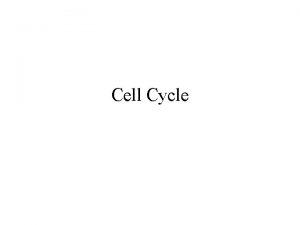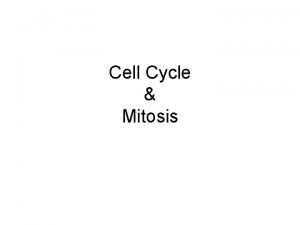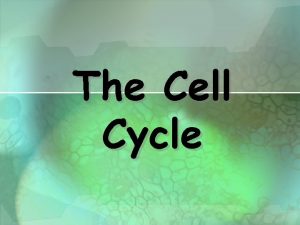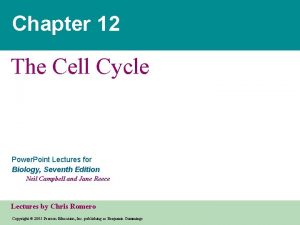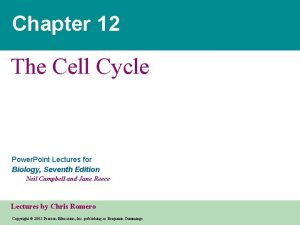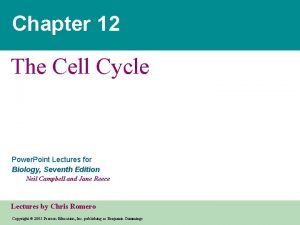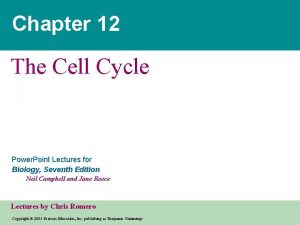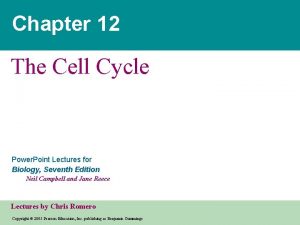Chapter 12 The Cell Cycle Power Point Lectures






























- Slides: 30

Chapter 12 The Cell Cycle Power. Point Lectures for Biology, Seventh Edition Neil Campbell and Jane Reece Lectures by Chris Romero Copyright © 2005 Pearson Education, Inc. publishing as Benjamin Cummings

• Overview: The Key Roles of Cell Division • The continuity of life – Is based upon the reproduction of cells, or cell division Figure 12. 1 Copyright © 2005 Pearson Education, Inc. publishing as Benjamin Cummings

• Unicellular organisms – Reproduce by cell division 100 µm (a) Reproduction. An amoeba, a single-celled eukaryote, is dividing into two cells. Each new cell will be an individual Figure 12. 2 A organism (LM). Copyright © 2005 Pearson Education, Inc. publishing as Benjamin Cummings

• Multicellular organisms depend on cell division for – Development from a fertilized cell – Growth – Repair 200 µm 20 µm (b) Growth and development. (c) Tissue renewal. These dividing This micrograph shows a bone marrow cells (arrow) will sand dollar embryo shortly give rise to new blood cells (LM). after the fertilized egg divided, Figure 12. 2 B, C forming two cells (LM). Copyright © 2005 Pearson Education, Inc. publishing as Benjamin Cummings

• The cell division process – Is an integral part of the cell cycle Copyright © 2005 Pearson Education, Inc. publishing as Benjamin Cummings

• Concept 12. 1: Cell division results in genetically identical daughter cells • Cells duplicate their genetic material – Before they divide, ensuring that each daughter cell receives an exact copy of the genetic material, DNA Copyright © 2005 Pearson Education, Inc. publishing as Benjamin Cummings

Cellular Organization of the Genetic Material • A cell’s endowment of DNA, its genetic information – Is called its genome Copyright © 2005 Pearson Education, Inc. publishing as Benjamin Cummings

• The DNA molecules in a cell – Are packaged into chromosomes Figure 12. 3 50 µm Copyright © 2005 Pearson Education, Inc. publishing as Benjamin Cummings

• Eukaryotic chromosomes – Consist of chromatin, a complex of DNA and protein that condenses during cell division • In animals – Somatic cells have two sets of chromosomes – Gametes have one set of chromosomes Copyright © 2005 Pearson Education, Inc. publishing as Benjamin Cummings

Distribution of Chromosomes During Cell Division • In preparation for cell division – DNA is replicated and the chromosomes condense Copyright © 2005 Pearson Education, Inc. publishing as Benjamin Cummings

• Each duplicated chromosome – Has two sister chromatids, which separate during cell division 0. 5 µm A eukaryotic cell has multiple chromosomes, one of which is represented here. Before duplication, each chromosome has a single DNA molecule. Once duplicated, a chromosome consists of two sister chromatids connected at the centromere. Each chromatid contains a copy of the DNA molecule. Mechanical processes separate the sister chromatids into two chromosomes and distribute them to two daughter cells. Figure 12. 4 Copyright © 2005 Pearson Education, Inc. publishing as Benjamin Cummings Chromosome duplication (including DNA synthesis) Centromere Separation of sister chromatids Centromeres Sister chromatids

• Eukaryotic cell division consists of – Mitosis, the division of the nucleus – Cytokinesis, the division of the cytoplasm • In meiosis – Sex cells are produced after a reduction in chromosome number Copyright © 2005 Pearson Education, Inc. publishing as Benjamin Cummings

• Concept 12. 2: The mitotic phase alternates with interphase in the cell cycle • A labeled probe can reveal patterns of gene expression in different kinds of cells Copyright © 2005 Pearson Education, Inc. publishing as Benjamin Cummings

Phases of the Cell Cycle • The cell cycle consists of – The mitotic phase – Interphase INTERPHASE S (DNA synthesis) C M yto ito ki si ne s si s G 1 MI (M TOT ) P IC HA SE Figure 12. 5 Copyright © 2005 Pearson Education, Inc. publishing as Benjamin Cummings G 2

• Interphase can be divided into subphases – G 1 phase – S phase – G 2 phase Copyright © 2005 Pearson Education, Inc. publishing as Benjamin Cummings

• The mitotic phase – Is made up of mitosis and cytokinesis Copyright © 2005 Pearson Education, Inc. publishing as Benjamin Cummings

• Mitosis consists of five distinct phases – Prophase – Prometaphase G 2 OF INTERPHASE Centrosomes (with centriole pairs) Chromatin (duplicated) Figure 12. 6 Nucleolus Nuclear Plasma envelope membrane PROPHASE Early mitotic spindle Aster Centromere Chromosome, consisting of two sister chromatids Copyright © 2005 Pearson Education, Inc. publishing as Benjamin Cummings PROMETAPHASE Fragments Kinetochore of nuclear envelope Nonkinetochore microtubules Kinetochore microtubule

– Metaphase – Anaphase – Telophase METAPHASE ANAPHASE Metaphase plate Figure 12. 6 Spindle Centrosome at Daughter one spindle pole chromosomes Copyright © 2005 Pearson Education, Inc. publishing as Benjamin Cummings TELOPHASE AND CYTOKINESIS Cleavage furrow Nuclear envelope forming Nucleolus forming

The Mitotic Spindle: A Closer Look • The mitotic spindle – Is an apparatus of microtubules that controls chromosome movement during mitosis Copyright © 2005 Pearson Education, Inc. publishing as Benjamin Cummings

• The spindle arises from the centrosomes Copyright © 2005 Pearson Education, Inc. publishing as Benjamin Cummings

• Some spindle microtubules Aster Sister chromatids Centrosome Metaphase Plate Kinetochores Overlapping nonkinetochore microtubules Kinetochores microtubules Microtubules 0. 5 µm Figure 12. 7 Centrosome 1 µm Copyright © 2005 Pearson Education, Inc. publishing as Benjamin Cummings Chromosomes

• In anaphase, sister chromatids separate – And move toward opposite ends of the cell EXPERIMENT 1 The microtubules of a cell in early anaphase were labeled with a fluorescent dye that glows in the microscope (yellow). Kinetochore Spindle pole Figure 12. 8 Copyright © 2005 Pearson Education, Inc. publishing as Benjamin Cummings

• In telophase – Genetically identical daughter nuclei form at opposite ends of the cell Copyright © 2005 Pearson Education, Inc. publishing as Benjamin Cummings

Cytokinesis: A Closer Look • In animal cells – Cytokinesis occurs by a process known as cleavage, forming a cleavage furrow Contractile ring of microfilaments Figure 12. 9 A 100 µm Daughter cells (a) Cleavage of an animal cell (SEM) Copyright © 2005 Pearson Education, Inc. publishing as Benjamin Cummings

• In plant cells, during cytokinesis – A cell plate forms Vesicles forming cell plate 1 µm Wall of patent cell Cell plate New cell wall Daughter cells Figure 12. 9 B (b) Cell plate formation in a plant cell (SEM) Copyright © 2005 Pearson Education, Inc. publishing as Benjamin Cummings

• Mitosis in a plant cell Chromatine Nucleus Nucleolus condensing Chromosome Metaphase. The 2 Prometaphase. 3 1 Prophase. spindle is complete, 4 The chromatin We now see discrete and the chromosomes, is condensing. chromosomes; each attached to microtubules The nucleolus is consists of two at their kinetochores, beginning to identical sister are all at the metaphase disappear. chromatids. Later plate. Although not in prometaphase, the yet visible nuclear envelop will in the micrograph, fragment. the mitotic spindle is staring to from. Figure 12. 10 Copyright © 2005 Pearson Education, Inc. publishing as Benjamin Cummings Anaphase. The 5 chromatids of each chromosome have separated, and the daughter chromosomes are moving to the ends of cell as their kinetochore microtubles shorten. Telophase. Daughter nuclei are forming. Meanwhile, cytokinesis has started: The cell plate, which will divided the cytoplasm in two, is growing toward the perimeter of the parent cell.

Binary Fission • Prokaryotes (bacteria) – Reproduce by a type of cell division called binary fission Copyright © 2005 Pearson Education, Inc. publishing as Benjamin Cummings

• In binary fission – The bacterial chromosome replicates – The two daughter chromosomes actively move apart Origin of replication Cell wall E. coli cell 1 Chromosome replication begins. Soon thereafter, one copy of the origin moves rapidly toward the other end of the cell. 2 Replication continues. One copy of the origin is now at each end of the cell. 3 Replication finishes. The plasma membrane grows inward, and new cell wall is deposited. Figure 12. 11 4 Two daughter cells result. Copyright © 2005 Pearson Education, Inc. publishing as Benjamin Cummings Two copies of origin Origin Plasma Membrane Bacterial Chromosome Origin

The Evolution of Mitosis • Since prokaryotes preceded eukaryotes by billions of years – It is likely that mitosis evolved from bacterial cell division • Certain protists – Exhibit types of cell division that seem intermediate between binary fission and mitosis carried out by most eukaryotic cells Copyright © 2005 Pearson Education, Inc. publishing as Benjamin Cummings

• Malignant tumors invade surrounding tissues and can metastasize – Exporting cancer cells to other parts of the body where they may form secondary tumors Lymph vessel Tumor Blood vessel Glandular tissue 1 A tumor grows from a single cancer cell. Cancer cell 2 Cancer cells invade neighboring tissue. Figure 12. 19 Copyright © 2005 Pearson Education, Inc. publishing as Benjamin Cummings 3 Cancer cells spread through lymph and blood vessels to other parts of the body. Metastatic Tumor 4 A small percentage of cancer cells may survive and establish a new tumor in another part of the body.
 Molecular biology lectures
Molecular biology lectures Power system lectures
Power system lectures Cell cycle and cell division
Cell cycle and cell division Cell cycle and cell division
Cell cycle and cell division Biology.arizona.edu/cell bio/activities/cell cycle/01.html
Biology.arizona.edu/cell bio/activities/cell cycle/01.html Phases of cell cycle
Phases of cell cycle Active power reactive power apparent power
Active power reactive power apparent power Power bi power point
Power bi power point Point point power
Point point power The scientist mathias schleiden studied _______ in ______.
The scientist mathias schleiden studied _______ in ______. Rick trebino
Rick trebino Lectures paediatrics
Lectures paediatrics Data mining lectures
Data mining lectures Medicinal chemistry lectures
Medicinal chemistry lectures Uva powerpoint
Uva powerpoint Cs614 short lectures
Cs614 short lectures Step wise project planning
Step wise project planning Radio astronomy lectures
Radio astronomy lectures Dr sohail lectures
Dr sohail lectures Utilities and energy lecture
Utilities and energy lecture Web engineering lectures ppt
Web engineering lectures ppt How to get the most out of lectures
How to get the most out of lectures Frcr physics lectures
Frcr physics lectures Heel effect
Heel effect Cs106b lectures
Cs106b lectures Differentiation of rbc
Differentiation of rbc Define aerodynamics
Define aerodynamics Tamara berg husband
Tamara berg husband Theory and practice of translation lectures
Theory and practice of translation lectures Theory of translation lectures
Theory of translation lectures Digital logic design lectures
Digital logic design lectures































